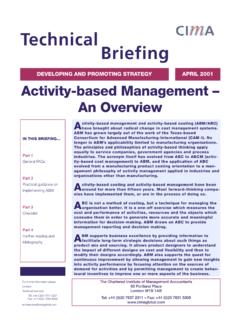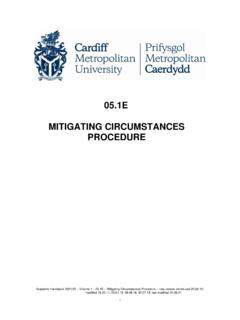Transcription of MDCG 2021-19
1 Medical Devices Medical Device Coordination Group document MDCG 2021-19 Page 1 of 10 MDCG 2021-19 Guidance note integration of the UDI within an organisation s quality management system July 2021 This document has been endorsed by the Medical Device Coordination Group (MDCG) established by Article 103 of Regulation (EU) 2017/745. The MDCG is composed of representatives of all Member States and it is chaired by a representative of the European Commission. The document is not a European Commission document and it cannot be regarded as reflecting the official position of the European Commission. Any views expressed in this document are not legally binding and only the Court of Justice of the European Union can give binding interpretations of Union law. Medical Devices Medical Device Coordination Group document MDCG 2021-19 Page 2 of 10 Introduction The Unique Device Identification (UDI) System1 should allow the identification of medical devices, facilitate appropriate traceability of medical devices, enhance the effectiveness of the post-market safety-related activities for devices, improve incident reporting, enhance targeting field safety corrective actions, lead to better surveillance, reduce medical errors, and help fight against falsified devices.
2 As such the UDI system is intended to be incorporated into the life-cycle of the device. In accordance with Article 27 of Regulation (EU) 2017/745 (MDR) and Article 24 of the Regulation (EU) 2017/746 (IVDR), the Unique Device Identification system as described in Part C of Annex VI MDR/IVDR , shall allow the identification and facilitate the traceability of devices, other than custom-made, investigational or performance study devices. The purpose of this document is to provide guidance on the integration of the UDI and the implementation of the UDI obligations as part of an organisation s Quality Management System (QMS) as required by Article 10(9)(h) MDR and 10(8)(h) IVDR. Economic operators concerned include manufacturers, in the case of Article 16(1) MDR/IVDR a distributor, importer or any other natural or legal person that assumes the obligations incumbent on manufacturers, and in case of Article 22(4) MDR the natural or legal persons that assumes the obligations incumbent on manufacturers.
3 This document should be read in conjunction with other available MDCG UDI Guidance Integration of UDI in the Quality Management System Amongst the applicable MDR/IVDR provisions to be included in the QMS of the manufacturer is Article 10(9)(h)/Article 10(8)(h) verification of the UDI assignments made in accordance with Article 27(3)/24(3) to all relevant devices and ensuring consistency and validity of information provided in accordance with Article 29/26 . When implementing the requirements of the MDR/IVDR related to the QMS, manufacturers should therefore consider how the UDI System and obligations can also be integrated. UDI (composed of the UDI-DI and UDI-PI) and Basic UDI-DI assignment, and management of the UDI-related information can impact many other lifecycle QMS The manufacturer could establish a UDI implementation plan, and use appropriate implementation tools as described in its QMS to allow correct assessment/decisions to be made and the proper documented evidence to be created, to ensure compliance with the Regulations regarding the UDI-system.
4 Elements of such a plan may include: 1 See recital (41) Regulation (EU) 2017/745. For definitions, please refer to relevant articles of the MDR/IVDR and Annex VI. 2 In particular MDCG 2018-3 Rev. 1, MDCG 2018-4, MDCG 2018-5, MDCG 2018-6 and MDCG 2018-7. All MDCG Guidance document can be found on the European Commission Medical devices website dedicated section. Please also see for additional information the IMDRF Guide Unique Device Identification system (UDI system) Application Guide - DOCX . 3 These aspects should be taken into particular consideration when setting the appropriate level of management of UDI implementation Medical Devices Medical Device Coordination Group document MDCG 2021-19 Page 3 of 10 analysis of expectations and needs of different stakeholders such as economic operators, healthcare institutions/professionals, patients/users, insurance providers.
5 Analysis of the relevant issuing entities standards; choice of a designated issuing entity4; definition of internal responsibilities for the implementation and subsequent management of the project plan; management and, if necessary, updates of the project plan implementation; description of methods and use cases, by which the proper running and continuous compliance of UDI-related QMS processes can be verified. The manufacturer may also assess the applicable UDI responsibilities when determining and documenting external roles ( third party suppliers, authorised representative, importers, distributors, systems and procedure packs producers). The following sections should be considered when integrating the UDI obligations in the different areas of the Quality Management System. Design and Development According to Article 27 (3) MDR and Article 24 (3) IVDR, before placing a device, other than a custom-made, investigational or performance study device, on the Union market, the manufacturer shall assign to the device and, if applicable, to all higher levels of packaging, a UDI created in compliance with the rules of the issuing entities designated by the Commission in accordance with paragraph 2 of the above mentioned Articles.
6 Moreover, according to Article 29 MDR and 26 IVDR, before placing a device, other than a custom made device, or a system or procedure pack on the market, the manufacturer or producer shall assign a Basic UDI-DI. For devices that are subject to a conformity assessment, the assignment of a Basic UDI-DI shall be done before the manufacturer applies to a notified body for that assessment. Manufacturers should consider the objectives and anticipated effects of the UDI system when designing and developing products5. The manufacturer should assure assignment of UDI-DIs prior to placing a device on the market or submitting a Technical Documentation to a notified body for conformity assessment, by using the rules of the issuing entities. In addition, the UDI-PI should properly replicate the production identifiers per MDR/IVDR Annex VI, Part C, and 6 respectively, which have been assigned to a device label based on risk management or regulatory requirement.
7 In addition to traceability, the appropriate level of product serialisation should also be done on the basis of proper risk management, consideration of regulatory requirements ( active implants require serial numbers6) and expectations or requirements of other stakeholders/national regulators such as registries7. 4 The issuing entities have been designated on 6 June 2019 in the Commission Implementing Decision (EU) 2019/939. 5 Example: successful implementation of the UDI system may be facilitated if critical safety parts/components are identified and the handling in case of field safety corrective actions is considered in advance. The life-cycle approach to the UDI integration would allow a more effective root cause analysis, and better traceability of such critical safety parts/components.
8 6 Annex I, Chapter III, section , point (s) MDR. 7 For example, national registries for implantable devices. Medical Devices Medical Device Coordination Group document MDCG 2021-19 Page 4 of 10 Procedures used for the assignment of UDI, the change of UDI8 and the corresponding degree of traceability (grouping of devices under a Basic UDI-DI or definition of their UDI-PI) should be appropriately documented. Product documentation and retention As part of the technical documentation, the manufacturer shall keep up-to-date a list of all UDIs (UDI-DIs and UDI-PIs) that it has assigned (Article 27(7) MDR, Article 24(7) IVDR). According to Article 10(8) MDR and Article 10(7) IVDR, manufacturers shall keep the technical documentation available for the competent authorities for a period of at least 10 years after the last device covered by the EU declaration of conformity has been placed on the Union market.
9 In the case of implantable devices, the period shall be at least 15 years after the last device has been placed on the Union market. Production and process Manufacturers may consider using the UDI, from the outset of the production phase to ensure the effective product information management. For example, the UDI-DI may be used as reference or catalogue number. The manufacturer should decide for each individual type/model when, where, and how the UDI carrier should be applied following various timelines per risk class , as required by the MDR/IVDR. 8 For more information, please see MDCG 2018-1 v4 Guidance on basic UDI-DI and changes to UDI-DI Medical Devices Medical Device Coordination Group document MDCG 2021-19 Page 5 of 10 As the UDI carrier may have an impact on manufacturing processes, in case of directly marked devices, it should be determined in advance if any exemptions in accordance with Point , Part C of Annex VI apply, to ensure that the requirements are fulfilled at the time the device is placed on the Union market.
10 For example, there are exemptions under MDR/IVDR as regards direct marking, in case it cannot be performed on certain devices9. Such exemptions should be documented, preferably in the technical documentation. In addition, device package levels will need to have the UDI carrier. Some labelling considerations: Manufacturers should ensure that, as part of their quality management system, the label printing process is verified and validated, and the equipment is used and maintained in accordance with relevant procedures. Changes to validated processes need to be assessed for impact on device labelling. The software used in implementing the UDI system ( UDI labelling of devices and packaging, machine to machine automatic upload of UDI data to EUDAMED) should remain in a validated state in accordance with relevant procedures.


















